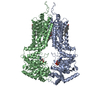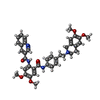+ Open data
Open data
- Basic information
Basic information
| Entry | Database: PDB / ID: 8bht | ||||||||||||
|---|---|---|---|---|---|---|---|---|---|---|---|---|---|
| Title | ABCG2 turnover-1 state with tariquidar bound | ||||||||||||
 Components Components | Broad substrate specificity ATP-binding cassette transporter ABCG2 | ||||||||||||
 Keywords Keywords | TRANSPORT PROTEIN / Multidrug resistance / ABC transporter | ||||||||||||
| Function / homology |  Function and homology information Function and homology informationbiotin transmembrane transporter activity / biotin transport / riboflavin transport / riboflavin transmembrane transporter activity / renal urate salt excretion / sphingolipid transporter activity / urate metabolic process / urate transmembrane transporter activity / Abacavir transmembrane transport / organic anion transport ...biotin transmembrane transporter activity / biotin transport / riboflavin transport / riboflavin transmembrane transporter activity / renal urate salt excretion / sphingolipid transporter activity / urate metabolic process / urate transmembrane transporter activity / Abacavir transmembrane transport / organic anion transport / external side of apical plasma membrane / sphingolipid biosynthetic process / organic anion transmembrane transporter activity / Sphingolipid de novo biosynthesis / xenobiotic transport across blood-brain barrier / transepithelial transport / export across plasma membrane / ABC-type xenobiotic transporter / Paracetamol ADME / Ciprofloxacin ADME / ABC-type xenobiotic transporter activity / NFE2L2 regulating MDR associated enzymes / cellular detoxification / Heme biosynthesis / Heme degradation / efflux transmembrane transporter activity / xenobiotic transmembrane transporter activity / transport across blood-brain barrier / ATPase-coupled transmembrane transporter activity / mitochondrial membrane / brush border membrane / Iron uptake and transport / transmembrane transport / membrane raft / apical plasma membrane / protein homodimerization activity / ATP hydrolysis activity / nucleoplasm / ATP binding / identical protein binding / plasma membrane Similarity search - Function | ||||||||||||
| Biological species |  Homo sapiens (human) Homo sapiens (human) | ||||||||||||
| Method | ELECTRON MICROSCOPY / single particle reconstruction / cryo EM / Resolution: 3.1 Å | ||||||||||||
 Authors Authors | Yu, Q. / Kowal, J. / Tajkhorshid, E. / Locher, K.P. | ||||||||||||
| Funding support |  Switzerland, Switzerland,  United States, 3items United States, 3items
| ||||||||||||
 Citation Citation |  Journal: Proc Natl Acad Sci U S A / Year: 2023 Journal: Proc Natl Acad Sci U S A / Year: 2023Title: Differential dynamics and direct interaction of bound ligands with lipids in multidrug transporter ABCG2. Authors: Ali Rasouli / Qin Yu / Sepehr Dehghani-Ghahnaviyeh / Po-Chao Wen / Julia Kowal / Kaspar P Locher / Emad Tajkhorshid /   Abstract: ABCG2 is an ATP-binding cassette (ABC) transporter that extrudes a wide range of xenobiotics and drugs from the cell and contributes to multidrug resistance in cancer cells. Following our recent ...ABCG2 is an ATP-binding cassette (ABC) transporter that extrudes a wide range of xenobiotics and drugs from the cell and contributes to multidrug resistance in cancer cells. Following our recent structural characterization of topotecan-bound ABCG2, here, we present cryo-EM structures of ABCG2 under turnover conditions in complex with a special modulator and slow substrate, tariquidar, in nanodiscs. The structures reveal that similar to topotecan, tariquidar induces two distinct ABCG2 conformations under turnover conditions (turnover-1 and turnover-2). μs-scale molecular dynamics simulations of drug-bound and apo ABCG2 in native-like lipid bilayers, in both topotecan- and tariquidar-bound states, characterize the ligand size as a major determinant of its binding stability. The simulations highlight direct lipid-drug interactions for the smaller topotecan, which exhibits a highly dynamic binding mode. In contrast, the larger tariquidar occupies most of the available volume in the binding pocket, thus leaving little space for lipids to enter the cavity and interact with it. Similarly, when simulating ABCG2 in the apo inward-open state, we also observe spontaneous penetration of phospholipids into the binding cavity. The captured phospholipid diffusion pathway into ABCG2 offers a putative general path to recruit any hydrophobic/amphiphilic substrates directly from the membrane. Our simulations also reveal that ABCG2 rejects cholesterol as a substrate, which is omnipresent in plasma membranes that contain ABCG2. At the same time, cholesterol is found to prohibit the penetration of phospholipids into ABCG2. These molecular findings have direct functional ramifications on ABCG2's function as a transporter. | ||||||||||||
| History |
|
- Structure visualization
Structure visualization
| Structure viewer | Molecule:  Molmil Molmil Jmol/JSmol Jmol/JSmol |
|---|
- Downloads & links
Downloads & links
- Download
Download
| PDBx/mmCIF format |  8bht.cif.gz 8bht.cif.gz | 206.5 KB | Display |  PDBx/mmCIF format PDBx/mmCIF format |
|---|---|---|---|---|
| PDB format |  pdb8bht.ent.gz pdb8bht.ent.gz | 164.5 KB | Display |  PDB format PDB format |
| PDBx/mmJSON format |  8bht.json.gz 8bht.json.gz | Tree view |  PDBx/mmJSON format PDBx/mmJSON format | |
| Others |  Other downloads Other downloads |
-Validation report
| Summary document |  8bht_validation.pdf.gz 8bht_validation.pdf.gz | 1.6 MB | Display |  wwPDB validaton report wwPDB validaton report |
|---|---|---|---|---|
| Full document |  8bht_full_validation.pdf.gz 8bht_full_validation.pdf.gz | 1.6 MB | Display | |
| Data in XML |  8bht_validation.xml.gz 8bht_validation.xml.gz | 45.6 KB | Display | |
| Data in CIF |  8bht_validation.cif.gz 8bht_validation.cif.gz | 64.7 KB | Display | |
| Arichive directory |  https://data.pdbj.org/pub/pdb/validation_reports/bh/8bht https://data.pdbj.org/pub/pdb/validation_reports/bh/8bht ftp://data.pdbj.org/pub/pdb/validation_reports/bh/8bht ftp://data.pdbj.org/pub/pdb/validation_reports/bh/8bht | HTTPS FTP |
-Related structure data
| Related structure data |  16069MC  8bi0C M: map data used to model this data C: citing same article ( |
|---|---|
| Similar structure data | Similarity search - Function & homology  F&H Search F&H Search |
- Links
Links
- Assembly
Assembly
| Deposited unit | 
| ||||||||||||||||||||||||||||||
|---|---|---|---|---|---|---|---|---|---|---|---|---|---|---|---|---|---|---|---|---|---|---|---|---|---|---|---|---|---|---|---|
| 1 |
| ||||||||||||||||||||||||||||||
| Noncrystallographic symmetry (NCS) | NCS domain:
NCS domain segments:
NCS oper: (Code: givenMatrix: (-0.542997149003, 0.116248923929, 0.831649135069), (0.178247531954, -0.951846631469, 0.249430967429), (0.820598509338, 0.283679709965, 0.496128923393)Vector: 9. ...NCS oper: (Code: given Matrix: (-0.542997149003, 0.116248923929, 0.831649135069), Vector: |
- Components
Components
| #1: Protein | Mass: 73526.938 Da / Num. of mol.: 2 Source method: isolated from a genetically manipulated source Source: (gene. exp.)  Homo sapiens (human) / Gene: ABCG2, ABCP, BCRP, BCRP1, MXR / Production host: Homo sapiens (human) / Gene: ABCG2, ABCP, BCRP, BCRP1, MXR / Production host:  Homo sapiens (human) / Strain (production host): HEK293-EBNA Homo sapiens (human) / Strain (production host): HEK293-EBNAReferences: UniProt: Q9UNQ0, ABC-type xenobiotic transporter #2: Chemical | #3: Chemical | #4: Chemical | ChemComp-R1H / | Has ligand of interest | Y | |
|---|
-Experimental details
-Experiment
| Experiment | Method: ELECTRON MICROSCOPY |
|---|---|
| EM experiment | Aggregation state: PARTICLE / 3D reconstruction method: single particle reconstruction |
- Sample preparation
Sample preparation
| Component | Name: ABCG2 in complex with Tariquidar under turnover condition Type: COMPLEX Details: ABCG2 was incubated with 5mM ATP, 5mM MgCl2, 0.5mM ADP, 20 uM Tariquidar at room temperature for 10 min Entity ID: #1 / Source: RECOMBINANT | ||||||||||||||||||||
|---|---|---|---|---|---|---|---|---|---|---|---|---|---|---|---|---|---|---|---|---|---|
| Molecular weight | Value: 0.144 MDa / Experimental value: NO | ||||||||||||||||||||
| Source (natural) | Organism:  Homo sapiens (human) Homo sapiens (human) | ||||||||||||||||||||
| Source (recombinant) | Organism:  Homo sapiens (human) / Strain: HEK293EBNA Homo sapiens (human) / Strain: HEK293EBNA | ||||||||||||||||||||
| Buffer solution | pH: 7.5 | ||||||||||||||||||||
| Buffer component |
| ||||||||||||||||||||
| Specimen | Conc.: 1 mg/ml / Embedding applied: NO / Shadowing applied: NO / Staining applied: NO / Vitrification applied: YES / Details: This sample was mono-disperse | ||||||||||||||||||||
| Specimen support | Grid material: COPPER / Grid mesh size: 400 divisions/in. / Grid type: Quantifoil R1.2/1.3 | ||||||||||||||||||||
| Vitrification | Instrument: FEI VITROBOT MARK IV / Cryogen name: ETHANE-PROPANE / Humidity: 100 % / Chamber temperature: 277.15 K |
- Electron microscopy imaging
Electron microscopy imaging
| Experimental equipment |  Model: Titan Krios / Image courtesy: FEI Company |
|---|---|
| Microscopy | Model: FEI TITAN KRIOS |
| Electron gun | Electron source:  FIELD EMISSION GUN / Accelerating voltage: 300 kV / Illumination mode: FLOOD BEAM FIELD EMISSION GUN / Accelerating voltage: 300 kV / Illumination mode: FLOOD BEAM |
| Electron lens | Mode: BRIGHT FIELD / Nominal magnification: 130000 X / Nominal defocus max: 2200 nm / Nominal defocus min: 600 nm / Cs: 2.7 mm / Alignment procedure: BASIC |
| Specimen holder | Cryogen: NITROGEN / Specimen holder model: FEI TITAN KRIOS AUTOGRID HOLDER |
| Image recording | Average exposure time: 1.49 sec. / Electron dose: 50 e/Å2 / Film or detector model: GATAN K3 BIOQUANTUM (6k x 4k) |
| EM imaging optics | Energyfilter name: GIF Quantum LS / Energyfilter slit width: 20 eV |
- Processing
Processing
| Software |
| ||||||||||||||||||||||||||||||||||||||||
|---|---|---|---|---|---|---|---|---|---|---|---|---|---|---|---|---|---|---|---|---|---|---|---|---|---|---|---|---|---|---|---|---|---|---|---|---|---|---|---|---|---|
| EM software |
| ||||||||||||||||||||||||||||||||||||||||
| CTF correction | Type: PHASE FLIPPING AND AMPLITUDE CORRECTION | ||||||||||||||||||||||||||||||||||||||||
| Particle selection | Num. of particles selected: 2939835 | ||||||||||||||||||||||||||||||||||||||||
| Symmetry | Point symmetry: C1 (asymmetric) | ||||||||||||||||||||||||||||||||||||||||
| 3D reconstruction | Resolution: 3.1 Å / Resolution method: FSC 0.143 CUT-OFF / Num. of particles: 211906 / Algorithm: FOURIER SPACE / Num. of class averages: 1 / Symmetry type: POINT | ||||||||||||||||||||||||||||||||||||||||
| Atomic model building | Protocol: OTHER / Space: REAL / Target criteria: cross-correlation coefficient | ||||||||||||||||||||||||||||||||||||||||
| Refinement | Cross valid method: NONE Stereochemistry target values: GeoStd + Monomer Library + CDL v1.2 | ||||||||||||||||||||||||||||||||||||||||
| Displacement parameters | Biso mean: 48.16 Å2 | ||||||||||||||||||||||||||||||||||||||||
| Refine LS restraints |
| ||||||||||||||||||||||||||||||||||||||||
| Refine LS restraints NCS | Type: NCS constraints / Rms dev position: 0.109850677646 Å |
 Movie
Movie Controller
Controller




 PDBj
PDBj















